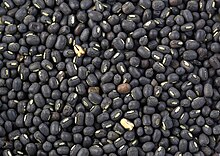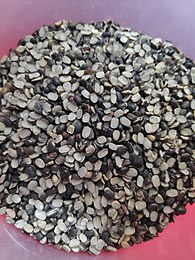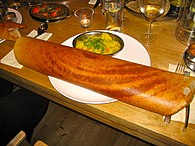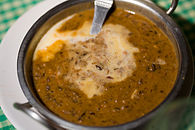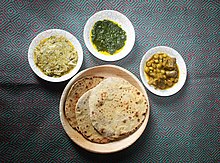Indian cuisine consists of a variety of regional and traditional cuisines native to the Indian subcontinent. Given the diversity in soil, climate, culture, ethnic groups, and occupations, these cuisines vary substantially and use locally available spices, herbs, vegetables, and fruits.

Vigna is a genus of plants in the legume family, Fabaceae, with a pantropical distribution. It includes some well-known cultivated species, including many types of beans. Some are former members of the genus Phaseolus. According to Hortus Third, Vigna differs from Phaseolus in biochemistry and pollen structure, and in details of the style and stipules.

Punjabi cuisine is a culinary style originating in the Punjab, a region in the northern part of South Asia, which is now divided in an Indian part to the east and a Pakistani part to the west. This cuisine has a rich tradition of many distinct and local ways of cooking.
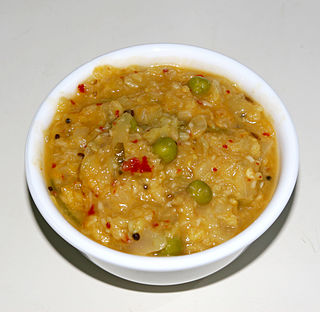
Koottu (Tamil:கூட்டு), often transcribed "kootu", is a lentil and vegetable stew in South Indian, particularly Tamil and Kerala cuisines. The etymology for koottu derives from the Tamil word "koottu" which means "add" or "mixture/medley" i.e. vegetable added with lentils form the dish, which is semi-solid in consistency. The dish is noted for its nutty and complex flavors and textures, likely owing to the liberal addition of lentils and coconuts. It is typically less watery than sambhar, but more so than dry stir-fries. Virundhu Sappadu comes with a combination of boiled rice, sambar, rasam, curd, poriyal, koottu, appalam, pickles and banana. All koottus by default have some vegetables and lentils, but many variations of koottu exist:
The Dogras or Dogra people, are an Indo-Aryan ethno-linguistic group living primarily in the Indian union territory of Jammu and Kashmir and neighbouring Pakistan, consisting of the Dogri language speakers. They live predominantly in the Jammu region of Jammu and Kashmir, and in adjoining areas of Punjab and Himachal Pradesh. Some also live in northeastern Pakistan. Their historical homeland is known as Duggar.

Rajasthani cuisine is the cuisine of the Rajasthan state in North West India. It was influenced by various factors like the warlike lifestyles of its inhabitants, the availability of ingredients in an arid region and by Hindu temple traditions of sampradayas like Pushtimarg and Ramanandi. Food that could last for several days and could be eaten without heating was preferred. Scarcity of water and fresh green vegetables have all had their effect on the cooking. Signature Rajasthani dishes include Dal Baati Churma, Panchratna Dal, Papad ro Saag, Ker Sangri, Gatte ro Saag. It is also known for its snacks like Bikaneri bhujia, Mirchi bada and Kanda kachauri. Other famous dishes include Dal Baati, malaidar special lassi (lassi) and Lashun ki chutney, Mawa lassi from Jodhpur, Alwar ka mawa, Malpauas from Pushkar and rasgulla from Bikaner, "paniya"and "gheriya" from Mewar. Originating for the Marwar region of the state is the concept Marwari Bhojnalaya, or vegetarian restaurants, today found in many parts of India, which offer vegetarian food of the Marwari people. The history also has its effect on the diet as the Rajputs preferred majorly a non-vegetarian diet while the Brahmins, Jains, Bishnois and others preferred a vegetarian diet. So, the state has a myriad of both types of delicacies.
Maharashtrian or Marathicuisine is the cuisine of the Marathi people from the Indian state of Maharashtra. It has distinctive attributes, while sharing much with other Indian cuisines. Traditionally, Maharashtrians have considered their food to be more austere than others.
The fast food industry in India has evolved with the changing lifestyles of the young Indian population. The variety of gastronomic preferences across the regions, hereditary or acquired, has brought about different modules across the country.
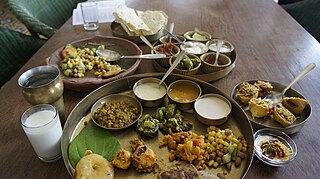
Gujarati cuisine is the cuisine of the Indian state of Gujarat. The typical Gujarati thali consists of rotli, dal or curry, rice, and shaak. The thali will also include preparations made from pulses or whole beans such as moong, black eyed beans etc., a snack item (farsaan) like dhokla, pathra, samosa, fafda, etc. and a sweet (mishthaan) like mohanthal, jalebi, sevaiya etc.
Udupi cuisine is a cuisine of South India. It forms an important part of Tuluva cuisine and takes its name from Udupi, a city on the southwest coast of India in the Tulunadu region of the state of Karnataka.

Dāl bhāt is a traditional meal from the Indian subcontinent. It consists of steamed rice and a cooked lentil or other pulses stew called dal. It is a staple food in these countries. Bhāt or chāwal means "boiled rice" in a number of Indo-Aryan languages.

Indian breads are a wide variety of flatbreads and crêpes which are an integral part of Indian cuisine. Their variation reflects the diversity of Indian culture and food habits.
Bhojpuri cuisine is a style of food preparation common among the Bhojpuri people of Bihar and eastern Uttar Pradesh in India, and also the Terai region of Nepal. Bhojpuri foods are mostly mild and tend to be less hot in terms of spices used. The cuisine consists of both vegetable and meat dishes.
Goan cuisine consists of regional foods popular in Goa, an Indian state located along India's west coast on the shore of the Arabian Sea. Rice, seafood, coconut, vegetables, meat, bread, pork and local spices are some of the main ingredients in Goan cuisine. Use of kokum and vinegar is another distinct feature. Goan food is considered incomplete without fish.

Andhra cuisine, culturally known as Telugu cuisine, is a cuisine of India native to the state of Andhra Pradesh and is the culinary style of Telugu people. It is generally known for its tangy, hot, and spicy taste.

Malaysian Indian cuisine, or the cooking of the ethnic Indian communities in Malaysia, consists of adaptations of authentic dishes from India, as well as original creations inspired by the diverse food culture of Malaysia. Because the vast majority of Malaysia's Indian community are of South Indian descent, and are mostly ethnic Tamils who are descendants of immigrants from a historical region which consists of the modern Indian state of Tamil Nadu and Sri Lanka's Northern Province, much of Malaysian Indian cuisine is predominantly South Indian inspired in character and taste. A typical Malaysian Indian dish is likely to be redolent with curry leaves, whole and powdered spice, and contains fresh coconut in various forms. Ghee is still widely used for cooking, although vegetable oils and refined palm oils are now commonplace in home kitchens. Before a meal it is customary to wash hands as cutlery is often not used while eating, with the exception of a serving spoon for each respective dish.

In Indian cuisine, dal, paruppu, or pappu are dried, split pulses that do not require soaking before cooking. India is the largest producer of pulses in the world. The term is also used for various soups prepared from these pulses. These pulses are among the most important staple foods in South Asian countries, and form an important part of the cuisines of the Indian subcontinent.

Vada, vadai, wada, or bara is a category of savoury fried snacks native to India. Vadas can be described variously as fritters, cutlets, or dumplings. Vadas are sometimes stuffed with vegetables and traditionally served with chutneys and sambar.
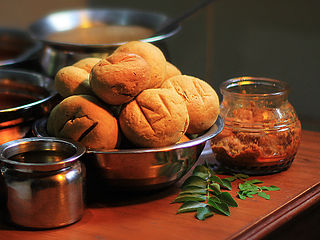
Daal Baati is an Indian dish of daal (lentils) and baati. It is popular in Rajasthan, Madhya Pradesh, Maharashtra's Khandesh and Vidarbha region, Gujarat, and Uttar Pradesh.

Medu vada is a South Indian breakfast snack made from Vigna mungo. It is usually made in a doughnut shape, with a crispy exterior and soft interior. A popular food item in South Indian cuisine it is generally eaten as a breakfast or a snack.
